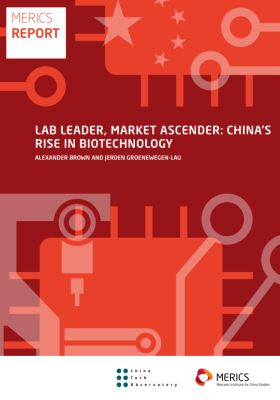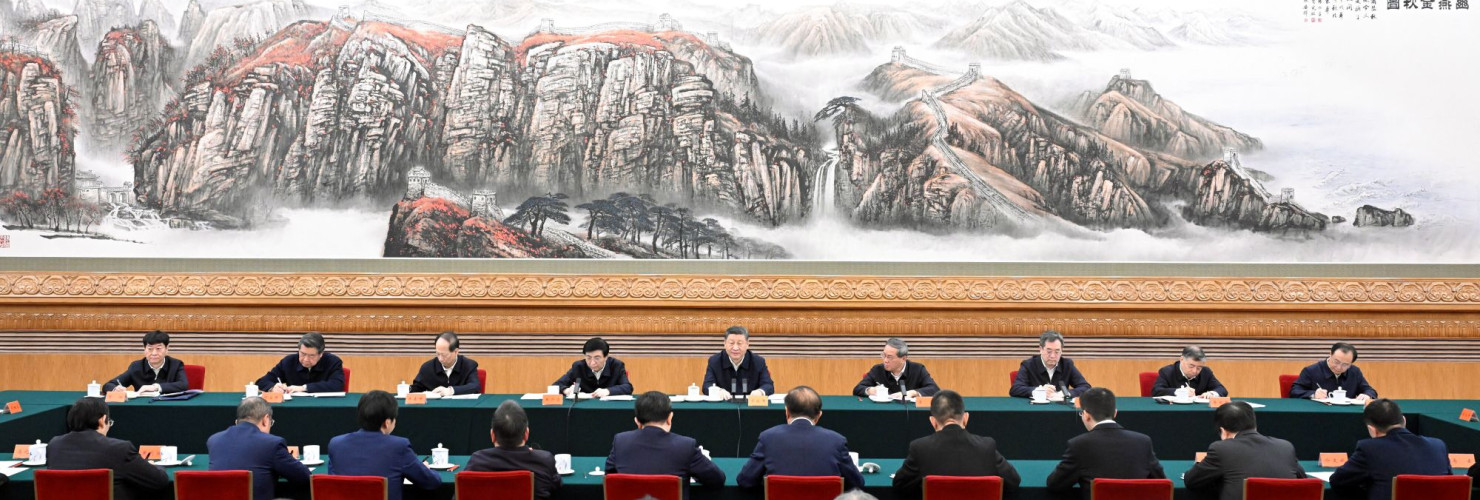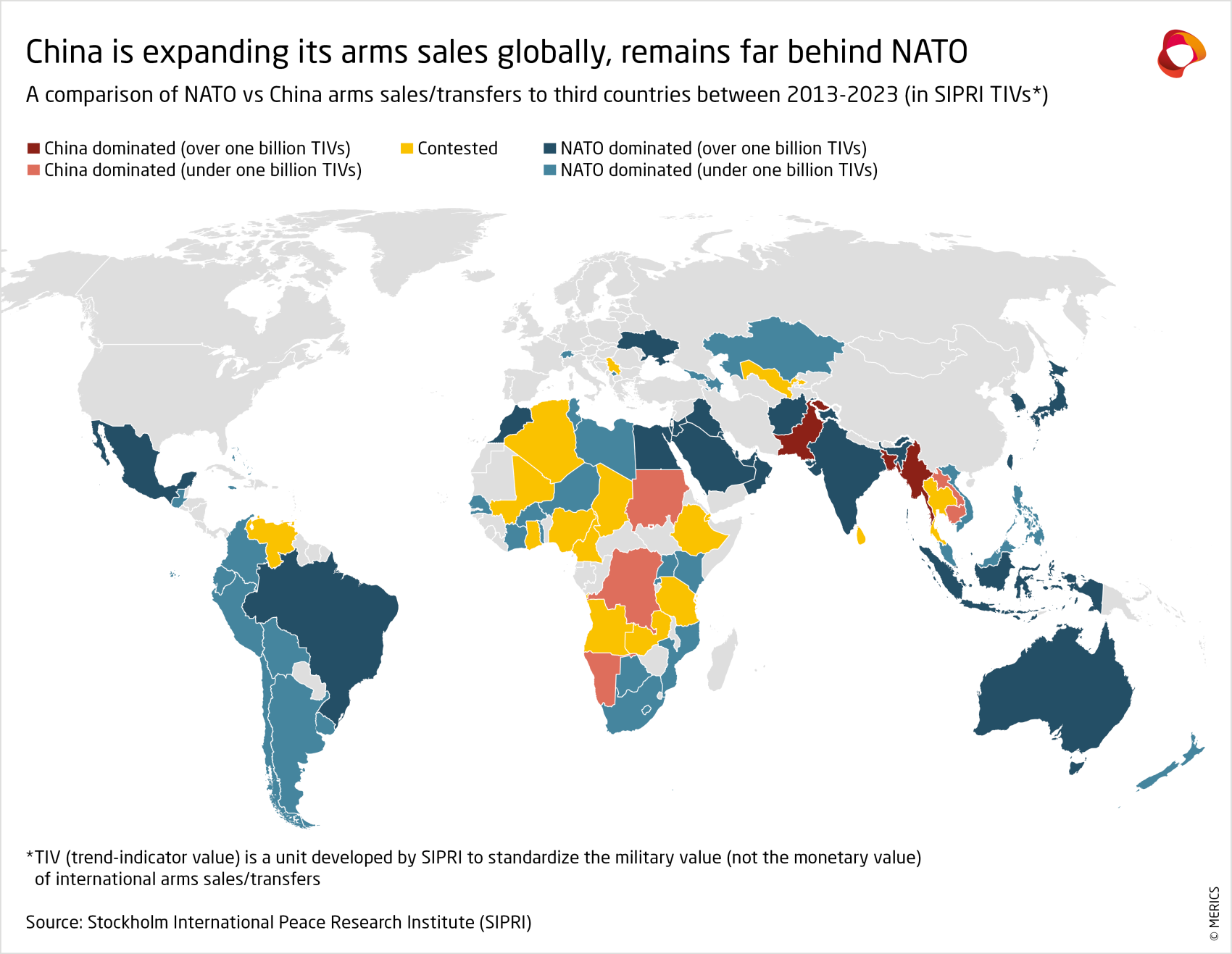

National security white paper + China-Latin America + US-China relations
Top story
National security white paper posits China as safe harbor that will stay its course
As the world faces multiple geopolitical risks, China is a beacon of stability, asserts Beijing’s new white paper on national security. Released to great media fanfare in mid-May, the paper faults the US and the West for the messy state of world affairs. Even as it acknowledges the fraught international environment and domestic challenges like the economy, real estate market, and consumer confidence, the paper reinforces Beijing’s focus on economic resilience and technological self-reliance – a sign the leadership has no intention of shifting gears.
The paper claims China’s constructive role is fostering relative security in the Asia-Pacific region – even if its neighbors differ. It links the secure domestic environment to its comprehensive national security concept. Introduced by Xi Jinping in 2014, the concept has grown to encompass 20 areas of security and is required reading on all party levels. The paper also highlights protecting social stability through policing and keeping the general public content in a time of transformation as key tasks.
The “biggest threat” to security is “not developing,” the document states, showing that Beijing is not letting up on its pursuit of resilience and self-reliance. While supply chain and energy security and domestic economic support – including boosting consumption – are all mentioned, China’s advancement as an innovation power is the central theme.
China still needs a beneficial international environment, but the party state is willing to defend its development interests with an iron hand. Despite plenty of references to “opening up,” the document makes clear this will only happen on Beijing’s own terms and in full consideration of its security interests. The paper underscores that only the Communist Party can deliver on the promise of a bright future, and protecting the party is the first order of business. It also showcases the belief that China is up to tackling any challenges thrown its way, boosted by its perceived victory in the recent tariff spat.
The main audience for the lengthy paper is China’s cadres and citizens. It gives high marks for the period of the current (non-public) national security strategy (2021-2025) and indicates what is ahead for the years to come. Modernizing the national security system and enforcement capabilities, as well as a stronger international focus are key areas to watch, with China’s Global Security Initiative likely gaining further prominence in its international engagements.
“Make no mistake: external pressure will not get China to change course on its key strategies of self-reliance and selective access to the country. The white paper shows that the leadership remains convinced of its path and is using the current geopolitical uncertainty to advance its interests and boost its global standing.”
Katja Drinhausen, Head of Program Politics and Society, MERICS
Media coverage and sources:
- Chinese government website: Full text of White Paper in Chinese
- The Diplomat: China’s 2025 National Security White Paper: ‘Holistic Security’ amid rising global tensions
- The National Bureau of Asian Research: An analysis of China’s White Paper on National Security in the New Era
METRIX
1
This is the percentage by which China‘s carbon dioxide emissions fell over the twelve months to the end of March 2025. This annual decline – the first ever – occurred despite a 2.5 percent increase in power consumption. New clean energy capacity, especially wind and solar, not only covered this rise in demand for electricity but also provided enough capacity to make up for lower output from coal- and gas-fired power stations. Faster economic growth and cyclical surges in industrial output could yet lead to emissions rising again. Nevertheless, this is a strong sign that the world’s largest emitter of greenhouse gas is beginning to see a long-term decline in CO₂ emissions. (Source: carbonbrief.org)
Topics
China woos Latin American and Caribbean states with talk of multilateralism
China hosted over 30 leaders from the Community of Latin American and Caribbean States (CELAC) mid-May as part of a long-term bid to strengthen its influence in a region the United States’ views as its “backyard”. Beijing used the China-CELAC Forum to pledge 66 billion CNY (8.6 billion EUR) in credit lines for infrastructure development, increasing imports from the region, and boosting investments there. After flying in from Russia’s World War II Victory Day celebrations in Moscow, Brazilian President Luiz Inácio Lula da Silva signed more than 30 bilateral agreements. Brazil and China also issued a joint statement calling for direct dialogue between Kyiv and Moscow to end the War in Ukraine, offering help “to resolve the crisis together with the countries of the global South.”
Amid intensifying geopolitical competition with Washington, Beijing is promoting a narrative of South-South cooperation: “China is willing to jointly oppose unilateralism and economic bullying with Latin American countries,” as Miao Deyu, the Assistant to the Chinese Foreign Minister, said. China and CELAC countries see deepening cooperation as a way to counter the effects of US President Donald Trump’s tariffs and retreat from multilateralism. At the same time, the China-Brazil dynamic illustrates that the region is not beholden to Beijing. Although both countries claim an "interest in exploring synergies" in their development agendas, Brazil has not officially joined the China-led Belt and Road Initiative—unlike Colombia, which formally joined during the summit.
The Brazil-China dynamic reflects a shared interest in countering Trump’s ‘America First’ policies. Beijing hopes to rally more countries—especially those from the Global South—to boost China’s global standing for shaping an alternative global order. But, for many, choosing sides between China and the US runs contrary to their idea of multilateralism.”
Claus Soong, Analyst at MERICS
Media coverage and sources:
- Reuters: Brazil's Lula courts trade ties in Beijing as China spars with Trump
- New York Times: China courts Lula and Latin America after Trump’s tariff shock
- Lianhe Zaobao (CN): 北京举办论坛加强对“美国后院”影响力 (Beijing hosts forum to strengthen its influence over the "US backyard")
- China’s MFA (CN): 中国巴西关于乌克兰危机的联合声明 (China-Brazil Joint Statement on the Ukraine Crisis)
- Brazil’s MFA: Joint Communiqué between the Federative Republic of Brazil and the People’s Republic of China on the deepening of their Global Strategic Partnership
US-China trade war ceasefire is good, but won’t yield a long-term solution
The ceasefire in the US-China trade war shows that the intensity of escalation was unsustainable, but ongoing tensions in the relationship presage further decoupling. After significant economic pain – for China, lost market access, for the US, rising prices and potential shortages and damage to small businesses – both countries had good reason to come down a few steps on the escalation ladder. Even though both have agreed not to escalate further, the remaining tariff baseline will still be disruptive to trade.
The US and China now have less than 90 days to work out a deal – and few possibilities to do so. Both parties’ demands are virtually irreconcilable: China would effectively have to dismantle its economic model to meet US demands, while the US would have to open its market and technology to nearly pre-trade war levels to satisfy China. Some marginal deals are possible in the short term, but the fundamental economic imbalances driving decoupling and the broader geopolitical dynamics will be very hard to overcome.
While the US and China have responded to the acute dangers of their rapid escalation, the chances of a deal on the fundamental issues are close to zero. European policymakers and executives should not expect further rapprochement between the US and China and should prepare to weather the gathering storm.”
Jacob Gunter, Lead Analyst at MERICS
Media coverage and sources:
China demonstrates its weapons capabilities in India-Pakistan clash
The recent short but sharp conflict between India and Pakistan after a terrorist attack in India-administered Kashmir has allowed the Chinese defense industry to show its prowess. Pakistan reportedly used a Chinese J-10C fighter jet to down at least one Indian-flown French Rafale and successfully combined the use of Chinese aircraft with Chinese-made drones and air defense systems. The debris of a Chinese long-range air-to-air missile was found on Indian soil, in proximity to a downed Indian Airforce Rafale aircraft. China has been building up its military in recent years, but its army has not fought a war since the Sino-Vietnam war of 1979, making its progress difficult to gauge.
China has become the world’s fourth largest arms exporter, allowing it to see its weapons used in actual combat scenarios by other countries. The J-10C, an update of the first Chinese-made fighter jet not based on Soviet models, demonstrates the country’s methodical self-sufficiency campaign. While early versions used Russian-made engines, the newest are reportedly using a Chinese-made model, in addition to a domestically produced radar. Chinese commenters like to stress its lower cost and higher rate of production: China reportedly produced 227 J-10Cs since 2004 at a unit price of 40-50 million USD, while Dassault has produced 299 Rafales since the mid-1980s at a unit price of 288 million USD.
China has in recent years ramped up its arms exports after raising the technological sophistication and production capacity of its military suppliers. The country can capitalize on its strengths in mass production and low-cost manufacturing and provide a wide range of interconnected weapons systems with sensor integration.”
Antonia Hmaidi, Senior Analyst at MERICS
More on the topic:
- China’s arms industry is increasingly global, but don’t expect it to supplant NATO’s counterparts any time soon, MERICS China Security and Risk Tracker by Jacob Gunter and Helena Legarda
Media coverage and sources:
- 163.com (CN): J10C就能把桌子掀了,还真当中国是纸老虎? (The J10C can make a splash. Do you really think China is a paper tiger?)
- SCMP: J-10C’s DeepSeek moment? Beijing muted as China cheers fighter jet combat reports
- The Diplomat: India-Pakistan Military Crisis: A testing ground for Chinese military hardware
China banks on AI and other tech to improve education at home and abroad
China has reasserted its commitment to using advanced technology in education by pledging to integrate more AI into teaching and learning, promote a national platform for smart education and deepen international exchanges. In a white paper published at the World Digital Education Conference last week in Wuhan, the Ministry of Education declared 2025 China’s first “smart education” year in a bid to lower education gaps – disparities in access and outcomes between different groups of people – both at home and abroad. It also listed multilateral education initiatives in Africa and other regions of the Global South and co-operation agreements with Spain and Italy, among other countries.
Consistent with China’s aim of becoming a global standard setter in this area, the white paper outlined the promotion of President Xi Jinping’s vision of a “community of shared future” through education. Bridging education gaps worldwide is one of the UN’s Development Goals, but the document also acknowledged that its smart education model would give other countries the chance to adopt “Chinese solutions”, for example, for students to “establish a correct outlook on life, worldview and values”. Beijing in January said it wanted to become a “leading country in education” by 2035 and underlined ideological and political controls first item in its plan.
Beijing sees education technologies as a new frontier on which to assert China’s influence overseas. It is doubling down in this area to reinforce its global standing.”
Daria Impiombato, Senior Analyst at MERICS
Media coverage and sources:
- Chinese government website: The Central Committee of the Communist Party of China and the State Council issued the "Outline of the Plan for the Construction of a Strong Country in Education (2024-2035)"
- China’s Ministry of Education (MOE): China Smart Education White Paper 2025; 2025 World Digital Education Conference; The White Paper on Smart Education in China was released
MERICS China Digest
China warns of legal consequences to those involved in US chip measures (Reuters)
Beijing said it could take legal action against those involved in the implementation of US measures against using advanced semiconductors from China. Washington last week said that companies risk violating export controls if they use Huawei’s Ascend AI chips (25/05/21)
China is expanding its use of AI surveillance tools to monitor online activity and assist police investigations, as highlighted at a major exhibition on police equipment in Beijing. (25/05/17)
Lai Ching-te, who was inaugurated as Taiwan’s president a year ago, has reiterated calls for peace and dialogue with China, telling journalists that a war would have “no winners”. China’s official state media, Xinhua, accused Lai of “deliberately escalating” cross-Strait tensions with his remarks. (25/05/20)
EU to charge EUR 2 fee for Temu, Shein packages (POLITICO)
The European Commission proposed a 2 EUR fee for packages from Chinese e-commerce firms. The fees would apply to packages under 150 EUR in value and are meant to tackle the flood of cheap packages from China. (25/04/20)
The Chinese government issued strict new austerity rules banning lavish spending by officials to curb corruption and address rising debt. The measures aim to ensure public funds are used efficiently and reflect growing concerns over China’s fiscal challenges. (25/05/19)
An investigation of the International Consortium of Journalists (ICIJ) exposes how Beijing abuses international institutions, including Interpol and the United Nations, to put pressure on its critics and extend its repressive tactics worldwide. (25/04/29)
Explainer: What to know about HK’s Article 23 security law update (Hong Kong Free Press)
Hong Kong’s latest Article 23 security law update introduces six new offences to facilitate the work of Beijing’s Office for Safeguarding National Security (OSNS), with penalties ranging up to seven years in prison and fines of up to 500,000 HKD (56,550 EUR). The law raises serious concerns about government overreach. (25/05/18)
Will China’s private economy promotion law reassure its private sector? (Brookings)
On May 20, China’s private economy support law went into effect. The law aims to boost confidence amid declining investment and economic challenges, but according to analysts it faces some major issues that will hinder its effectiveness in reassuring private investors. (25/03/28)
China announces new stimulus plan (Sixth Tone)
China has launched a major new stimulus plan to counter economic challenges, including interest rate cuts, a cut to the reserve requirement ration, and targeted support for key sectors such as technology and real estate. These measures are expected to inject about 1 trillion CNY (123 billion EUR) in liquidity and boost market confidence. (25/05/07)
